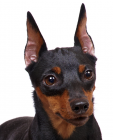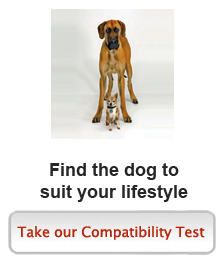Miniature Pinscher
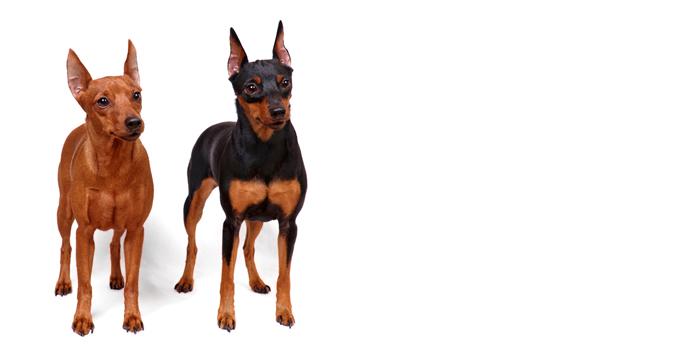
In my own words
Oh what are you doing? Can I have a look? Let me see! I don’t care if it’s boring, I want to have a look. I’m quite a curious dog you see, I like to know everything that’s going on. I guess I can be a little bossy sometimes too... So what are you doing then? Can we play a game or have a cuddle? I love cuddles! I love games! But I don’t really like playing with those little kids, they are too crazy for me. I’d much rather play with you instead!
Do you have any rats you need catching? I’m an excellent rat-catcher you see, that’s what my kind was bred for. Isn’t that good? I promise I won’t leave it on your doorstep. I am just excited to show you how fast am I. Being fast makes me pretty good at agility too, shall we have a go at that? I like to be active you see, do you reckon you can keep up with me?
My ideal owner(s)
Singles
Families
City dwellers
What they say about me
Active and lively
Curious
Elegant
Proud
Please read on, to find out more about me, and whether I will be someone you can be happy with for the next 15 years, or even longer
Is this Miniature Pinscher for you?
Test your knowledge about the Miniature Pinscher
Information essential about the Miniature Pinscher
Kennel Club Group:
Toy
Size:
Small: Weight 8 – 10 lb (3.6 – 4.5 kg)
Height 10 – 12” (25.4 – 30.5 cm)
Popularity:
Breed History:
The Miniature Pinscher originated in Germany. The breed’s earliest ancestors were a mix of Italian Greyhounds and Dachshunds. The misconception that the Miniature Pinscher is a “miniature doberman” occurred because the Doberman Pinscher was introduced in the US first. The Miniature Pinscher was introduced to the AKC show ring in 1919. At this time it was officially referred to in Germany as the Zwergpinscher (dwarf pinscher) but the AKC referred to it simply as Pinscher and it was listed in the miscellaneous category.
The breed was officially introduced to the AKC in 1929 when the Miniature Pinscher Club of America (MPCA) petitioned for them to be placed in the Toy group. The name for this breed was officially changed to Miniature Pinscher in the US in 1972. The AKC’s description of the dog says that this breed is a “Miniature Doberman Pinscher” leading to the common misconception that this breed is a Miniature Doberman but is in fact, the older breed.
Factual documentation of the breed begins less than 200 years ago but historical artifacts and paintings indicate the breed is very old. Miniature Pinscher’s were developed hundreds of years ago to help farmers keep away rats.
Character:
Miniature Pinschers are recommended for experienced dog owners as they are an assertive, outgoing, active and independent breed. They make great agility dogs are they are very energetic but they can be escape artists so need to be kept in secured, fenced in areas. They are alert and wary of strangers so they make good watch dogs. It is recommended they young children do not play with this breed as the Miniature Pinscher does not appreciate rough playing.
Temperament:
This breed is quite highly strung and needs calm, patient socialisation and training. They are good learners but need a routine to keep them under control. They are happy with children provided the play is not too rough or boisterous and the Miniature Pinscher values its own personal space. They are extremely loyal and protective of their household. Their senses are very acute and they are very aware of outside movement or noise making them good watch or guard dogs. They will bark loudly if sensing danger but can become territorial as they grow older so need good socialisation and training to prevent this.
Conformation:
The Miniature Pinscher is a sturdy, compact, short-coupled and smooth coated dog. They are proud, vigorous and alert. Characteristic traits are his hackney-like action, fearless animation, complete self-possession and spirited presence. Legs should be straight with no bending in or out. This breed frequently has a docked tail and cropped ears but the AKC no longer requires ear cropping for shoes. They have a narrow head, flat skull and strong muzzles. The eyes are oval and ears erect. The neck is arched and blends into the shoulders. The body is well-muscled and the tail is erect.
Coat:
The coat is short and smooth.
Colour:
The colours allowed by the AKC are solid red, stag red, blue stag red, chocolate stag red, fawn stag red, and black, chocolate, blue and fawn with tan points and rust tan points. Occasionally they will have a small white patch located on the neck or breast area. The Miniature Pinscher once came in harlequin like that is found in the Great Dance. The harlequin gene is part of the makeup of this breed; though breeders for years have worked to eliminate this gene, but breeders have recently been breeding to bring the colour back by mixing the Rat Terrier into the Miniature Pinscher, though they are merle and not harlequin because they do not have the harlequin modifier or any white besides the small white patch on the breast area
Training:
They do not need an excessive amount of training but should not be spoiled. Too much pandering can allow them to become bossy so they need a firm but loving hand to keep their ego in check.
Care:
Their smooth short-haired coat requires little attention with only occasional brushing and shampooing. In cold weather care must be taken, jumpers or blankets can prevent the Miniature Pinscher from getting too cold. This is an active breed which needs access to a fenced yard or a daily walk.
Health:
Health:
The lifespan of a healthy individual is up to 15 years. If you buy from a reputable, responsible breeder, health problems should not occur. This breed is relatively healthy and free from major disorders but they can sometimes develop eye problems and joint issues. Take care not to overfeed this breed.
Exercise:
This breed requires a daily walk and can benefit from short runs but do not require excessive amounts of exercise.
You may also like:
If you like Miniature Pinschers, you may be interested in breeds of the same size »
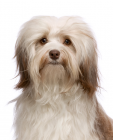
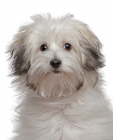



If you like Miniature Pinschers, you may like other breeds with similar characteristics »

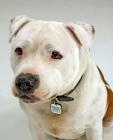
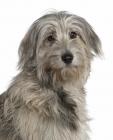
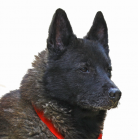
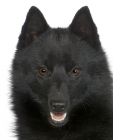
If you like Miniature Pinschers, you may be interested in these other toy dogs »
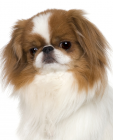
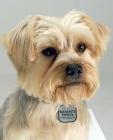
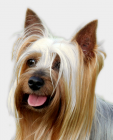

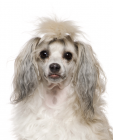
Advice on choosing your breed »
Find an animal shelter or rescue home where a Miniature Pinscher is waiting for a new home »
Min Pin's can be quite territorial and curious, a combination that can cause some to become possessive and even aggressive so be sure to establish the position of the dog in the house.
Sometimes called a one-person dog, Miniature Pinschers will usually get along with the entire family, including children—but they can be somewhat defensive and proud, which is not a good mix with very small children who might tease them.
Apartment life suits them just fine, as long as they get daily walks. Young children and playful adults should be warned: Miniature Pinschers don’t like to be handled roughly. They will nip if they feel physically threatened or uncomfortable.
The following grid gives a fast track review which covers all breeds. You can apply it to help you decide if a Miniature Pinscher is suitable for you, the environment where you live, your personality and your lifestyle. On the grid, 1= strongly disagree, and 5= strongly agree. For example, if you are looking for a good watch or guard dog, look down the list under Role and Suitability, and you will see that Miniature Pinscher make excellent guard and watch dogs, scoring 5. You might like to save or print off this section and keep it for reference while you check some other breeds before making your final choice.
Be the first to rate this breed »
|
*PLEASE NOTE: All our breed profiles are general, and all dogs are individuals. Always talk to the breeders and meet the owners you are buying from. Try to meet the dog and its parents if it is a puppy in their home environment.








